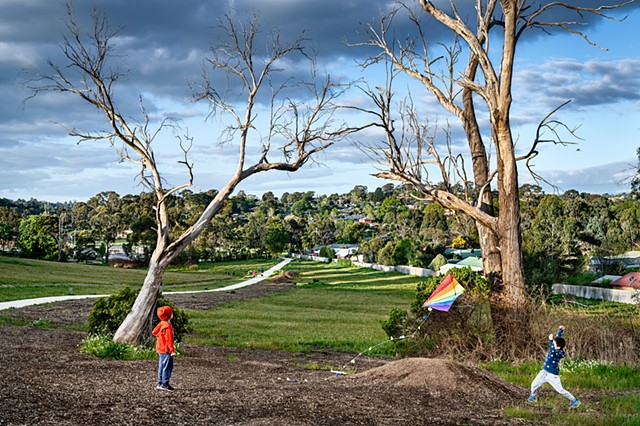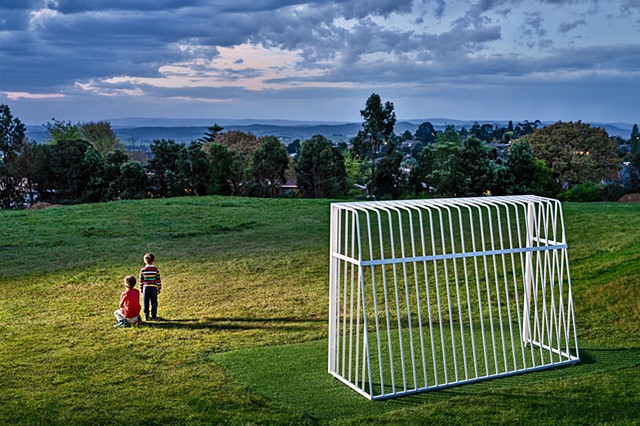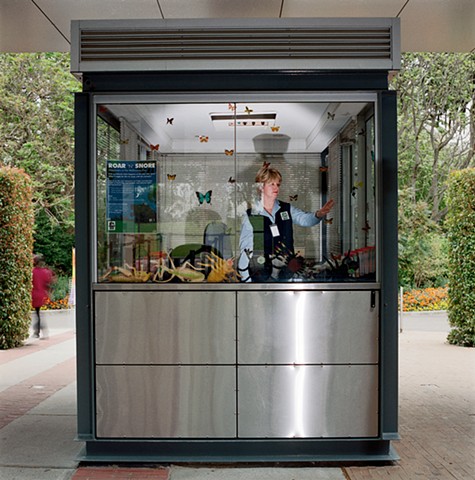Exhibition Launch of Neighbourhood Tales at Artspace at Realm
Please join us for the Exhibition Launch
Date: Thursday 20 July 2023
Time: 6pm to 7.30pm
With opening remarks by Kelly Gellatly, Director, Agency UntitledVenue: ArtSpace at Realm
Ringwood Town Square (opposite Ringwood Station)
Ground floor, 179 Maroondah Highway, Ringwood VIC
03 9298 4553
RSVP:Here'Neighbourhood Tales' is an exhibition of photographs produced in Maroondah and surrounding suburbs between 2020 and 2022 by Selina Ou, in collaboration with her two sons who appear in each of the images, sometimes together, sometimes alone.
Ou, an Australian artist of Malaysian Chinese descent, describes these artworks as “narrative landscape photographs”, meaning that she has invited her children to pose as figures within colour documentary images of local landscapes to tell stories about their shared experience of suburban life. Each image (or tale) is carefully staged and subtly lit, bringing a theatrical scenography to these familiar environments.
Selina Ou: Neighbourhood Tales
Curator: Dr Gareth Syvret
15/07/2023 - 17/09/2023
ArtSpace at Realm, 179 Maroondah Highway, Ringwood 3134
Monday to Friday: 9am to 8pm
Weekends and public holidays: 10am to 5pm@selinaou.photo @sophiegannongallery @artsinmaroondah @agencyuntitled @garethsyvret
Thanks to: John Meredith, my sons, our parents, Les Walkling, Sophie Gannon, Edwin Nicholls, Elizabeth Doan, Kelly Gellatly, Gareth Syvret, Mary Callahan, Will Taylor, Ethan Taylor, Imogen Taylor, John Taylor and Allison Taylor at Decently Exposed, mattrichards.tv, Garry Sommerfeld, Elise Murphy, Andrew Duong, Jane O'Neill, Sarah Werner, Candice Zaviska, Siri Hayes, Mia Mala McDonald, Stephanie Rose Wood, Andrew Baker, Stanley Foster, Kailah Welsh, Travis Harris, the Arts & Culture and Customer Service teams at Maroondah City Council and all involved in the making of this exhibition.
Opening Reception for Neighbourhood Tales and A Tendency Book Launch
Join us for the opening of Selina Ou’s highly anticipated solo exhibition Neighbourhood Tales and book launch for A Tendency, published by Karina Soraya and Greta Voeller.Neighbourhood Tales is a series of suburban narrative photographs that explore themes of the human condition, identity and the legacy of the Great Australian Dream.
A Tendency is a series of artists’ books interrogating contemporary practices of documentative nature. This publication is a mediator between editorial and artistic distribution by disseminating artworks inside each issue. This edition of A Tendency looks at the practice of photographer Selina Ou, discussing identity politics, societal structures and consumer culture. It is published by Karina Soraya and Greta Voeller.
Opening Reception for Neighbourhood Tales and A Tendency Book Launch
When: 2-4pm, Saturday 14th May 2022
Venue: Sophie Gannon Gallery, 2 Albert St, Richmond, Victoria, Australia. (Tue-Sat, 11am-5pm)
Free, no bookings required
This exhibition is part of this year’s PHOTO 2022 International Festival of Photography, taking place in galleries and public spaces across Melbourne and regional Victoria from 29 April to 22 May 2022.Selina Ou
Neighbourhood Tales | Photo 2022
Dates: 26 April 2022 - 21 May 2022
Venue: Sophie Gannon Gallery
2 Albert St, Richmond, Vic, Australia 3121
Opening hours: Tuesday - Saturday, 11am - 5pm
WHO ARE YOU: Australian Portraiture | NGVA
Anita (ticket seller), 2003 is currently on display in the exhibition WHO ARE YOU: Australian Portraiture in Naarm/Melbourne.
WHO ARE YOU: Australian Portraiture
Free entry
The Ian Potter Centre: NGV Australia, Fed Square
Melbourne, Victoria, Australia
Level 325 Mar 2022 – 21 Aug 2022
Open 10am–5pm dailyPlease come and see this beautiful exhibition of portraits if you are in town!
7:30 with Leigh Sales - Australian icons captured for posterity
To learn more about Professor Michelle Simmons and the portrait I took of her for the exhibition "20/20 Celebrating twenty years with twenty new portrait commissions" at the National Portrait Gallery, please enjoy this video: www.abc.net.au/7.30/australian-icons-ca… "CLANG!" ;)
New Portrait Commission
20/20 Celebrating twenty years with twenty new portrait commissions, National Portrait Gallery, Australia
In 2018, I was commissioned by the National Portrait Gallery to create a picture of Professor Michelle Simmons, 2018 Australian of the Year and a pioneer in atomic electronics and quantum computing. She is an exceptional individual and role model and it was an incredible honour and privilege to photograph Professor Simmons for the NPG's collection. www.portrait.gov.au/content/2020-michel…
Thank you so much to the National Portrait Gallery and the Sid and Fiona Myer Family Foundation, for this wonderful opportunity and experience. My gratitude also goes to Christopher Chapman, Edwin Nicholls, Sophie Gannon, Narelle Wilson, Patricia Butera, Garry Sommerfeld, Phil White, Bruce Howlett, Jennifer Kich, Mark Mohell, Gillian Raymond, Gabrielle Wilson, Monique Schafter, Patrick Stone, Marie Meredith, Micheal Meredith and John Meredith for contributing to the success of this project.
The portrait is now on display in the momentous exhibition 20/20 Celebrating twenty years with twenty new portrait commissions at the National Portrait Gallery in Canberra, Australia from Saturday 20 October 2018 until Sunday 10 February 2019, www.portrait.gov.au/exhibitions/20-20-2….
Please enjoy viewing all the outstanding portraits!
Author: Lily Hibberd
Selina Ou
Beside myself 2010The photographer loads, aims and fires a shot. This is the vernacular and ritual of camerawork. Like so many technologies of the west the camera lends itself to the dominant visual culture of its age. It has a single Cartesian-type eye, just one point of view. Monocularism is embodied in the body of the machine and it behaves accordingly. This operation is inherent to the movie camera too, as established by Laura Mulvey in Visual Pleasure and Narrative Cinema of 1973. Mulvey nailed that eye to the cross of the privileged male gaze and of scopophilia and what she argued as the predominantly masculine pleasure of cinematic spectatorship. Susan Sontag, likewise, pointed out the domineering and unitary (or phallocentric) tendencies of the camera: “To photograph people is to violate them, by seeing them as they never see themselves, by having knowledge of them they can never have; it turns people into objects that can be symbolically possessed.” We are faced therefore with an obvious contradiction: what happens when a woman uses this machine? Avoiding an essentialist reduction of feminine-masculine oppositions (an egg-cracking exercise in which the yolk is always broken into the white), let us consider how a camerawoman, a female artist, may or may not consciously deploy this machine. Is she in a position to undo or resist this dominant visual discourse and construct an alternate way of seeing? And what of her subjects?
Anti-Oedipus: capitalism and schizophrenia is Deleuze and Guattari’s guide to the advantages of multitudinous living – otherwise potentially cast as how to resist the hegemony of phallocentric thinking. To make a political surmise based on Ou’s images I would contend that women represent themselves here as implicitly anti-Oedipal, they are always all those others at once: mother, cook, friend, professional etc. Schizo? Yes. Let’s now consider the classic response that social analysis makes to the stereotype of the great multi-tasker upheld by all as “woman” today. This critique is overwhelmingly derisive of her lifestyle and connotes that women seem to be fragmenting or splitting as a result. Here we get the strong sense that women are thought to be on the edge of reason once more. (Schizo? Yes). They might be imagined to be on this edge, moreover, because of that old underlying propensity to madness. Remember that photography itself played an insidious role in substantiating female hysteria at the inception of both disciplines, most evidently during the age of “great confinement” in 17th century Paris at the Pitié-Salpêtrière asylum for women. This is precisely the point that Anti-Oedipus turns on; pivoting off its ideological axis to argue that schizophrenia is not the enemy. The enemy, as Deleuze and Guattari would have it, is the order of social intolerance to difference that disavows and disallows multiplicity and exiles it from society. This order demands all those who might threaten its sanctimonious sanity to be sanitised, hence the asylum.
To come at things visible again, to look at Ou’s photographs: what is apparent? There is a familiar documentary aesthetic of course yet there is also a form of social analysis at work. We see bodies in space (a politic of the physique taken up by women artists such as Julie Rrap) but we also see a room, the private space of this manifold human. Like Simryn Gill’s 2001 series, Dalam, Ou’s images reveal how these people live: their things and the arrangement of things; their clothes and “dress”; their bodies and gestures or “carriage”, and the sometimes quite classical compositions that play out through the poses that Ou has captured and re-placed in the scenes. This amounts to an incredibly layered and complex anthropology. Irreducible to any single style, label or habit, as such the “showing” that the photographs do is not the point at all. What is being elicited here is a “doing”. The women are acting for the camera yet with the sincerity of sharing their private lives with a photographer who, let it be said, is an ally. The apparent missing element is the assumed other, perhaps a sly statement of independence.
While the camera is unlikely to relinquish its hold over the subjective unitary imaginings of the modern eye and mind, in a move that Foucault proposed as the subject’s only hope against the power of the state and its institutions, the women in this work are taking apart the machine from within, designating themselves as split, multiplied; as many selves. They are interacting with the camera to revise the eye like Dziga Vertov did in 1929 (except it’s the “woman with the movie camera”), to ask the mind: What do we see ourselves as? Which of us, which of ourselves, is the locus of our being? The women who pose for Ou’s shots-within-shots are engaged – whether they subscribe to it or not – in the ongoing struggle for the acceptance of difference: they are mobile, transcursive and decentred; empowered and re-embodied by multiplicity. They show a way of resistance, just by being themselves.
Lily Hibberd 2010Footnotes:
1. Susan Sontag, On Photography. New York: Farrar, Straus and Giroux, 1977, 14.
2. Essentialism being left behind, especially since feminism is now generally conceived of being situated within the wider framework of (global) identity politics, and seen through the lens of cultural and social differentiation; racial and cultural otherness arguably having a common bond with women’s issues, whereby, on the level of human rights, everyone is a feminist. This fits the model of “difference” that underpins much of the feminist discourse surrounding recent contemporary art practice, taken up by major curated exhibitions such as Global Feminisms at Brooklyn Art Museum in 2007.
3. See Georges Didi-Huberman’s The Invention of Hysteria: Charcot and the Photographic Iconography of the Salpetriere, 2004, which examines the inseparable history of the treatment of women and the use photography at the Pitié-Salpêtrière hospital-asylum, Paris. Also note how the birth of this practice coincided with women’s suffrage in France in the 1780s and 1790s. See also Michel Foucault’s Madness and Civilisation, 1961.


